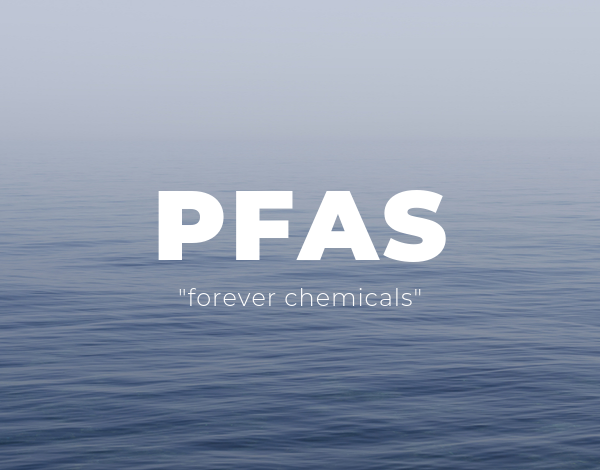What Was Once a Miracle of Modern Chemistry is Now a National Crisis Today
 Adding to the list of concerns that includes plastic pollution, landfill capacity, greenhouse gases and micro-plastics are PFAS.
Adding to the list of concerns that includes plastic pollution, landfill capacity, greenhouse gases and micro-plastics are PFAS.
Indestructible and almost impossible to avoid, PFAS (per- and polyfluoroalkyl substances) chemicals migrate into the soil, air, and water, never break down, and remain in the environment and people for decades.
Many scientists refer to PFAS as “forever chemicals" and estimate that nine thousand or more PFAS chemicals currently exist, creating a contamination crisis.
COMMERCIAL & CONSUMER GOODS WITH PFA
Used around the world, manufacturers have been adding highly fluorinated chemicals to a wide variety of industrial and consumer products since the 1940s to make non-stick cookware, carpeting, upholstery, cosmetics, waterproof apparel, floor waxes, cleaning products, paints, grease-proof food packaging, and even dental floss. Firefighting foams, and products that resist grease, water, and oil also have PFAS.
PFAS EXPOSURE
Because of widespread repeated use and persistence in the environment, scientists estimate that 99 percent of Americans today have PFAS in their bodies, and testing of umbilical cord blood and breast milk indicates that exposure to these chemicals begins before birth. Exposure to these human-made chemicals results from direct contact with products, through the air, or through the food and water they consume. Manufacturing processes, commercial applications, waste storage and treatment sites also release PFAS into the environment.
ENVIRONMENTAL IMPACT OF PFAS
PFAS are among the most encountered synthetic chemicals in the world. While their strong chemical bonds make them amazingly effective at repelling water and oil even at hot temperatures, these same characteristics also make PFAS extremely persistent, meaning they do not break down and consequently allow them to accumulate over time in the environment and in the bodies of animals and people, posing serious health risks.
PFAS HEALTH RISKS
Researchers are concerned about the public’s exposure to PFAS in the population because scientific studies have shown that lose dose exposure to some PFAS in the environment may be linked to harmful health effects in animals and humans such as kidney and testicular cancer, altered mammary gland development, thyroid disease, high cholesterol, reproductive problems, low birth weight, increased risk of birth defects, decreased effectiveness of vaccines in children, and effects on the immune system.
REGULATION
Unfortunately, the U.S. Environmental Protection Agency (EPA) does not regulate or test for most PFAS chemicals and manufacturers do not have to disclose to consumers that they are using PFAS. Sadly, our government allows products made with PFAS to be imported into the country. There are at least 475 industrial facilities discharging PFAS into the environment yet there are currently no restrictions on industrial PFAS discharges under the federal Clean Water Act or the Clean Air Act.
Lastly, the EPA and the Food and Drug Administration have recklessly allowed the introduction of scores of “short chain” replacements claiming this structure is safer, yet studies show that short-chains may pose even worse risks than long-chains.
WHAT CAN BE DONE?

You can avoid water and stain-repellent carpeting and textiles and food packaged in grease proof bags or containers. Encourage restaurants to ditch food containers and packaging containing PFAS. Be aware that not all compostable packaging is PFAS-free: instead, choose BPI®-certified packaging and ask about it at restaurants that use compostable type food and drink containers.
Cook with stainless steel, cast iron, glass, or ceramic cookware instead of non-stick options. Read personal care products and cosmetic labeling carefully and avoid those with “perfluor-,” “polyfluor-,” “PTFE,” or Teflon on the label. Find out if your water source evaluates for PFAS. If you drink bottled water, try to purchase water labeled “purified,” rather than spring water.
Given the presence of PFAS chemicals and the wide range of associated health effects, there is an urgent need to understand people’s exposure to PFAS in their everyday lives. The reality is, we need to act on the full class of these toxic “forever chemicals” to clean them up, phase them out, and then ban them for good. Protect the environment now and future generations to come - be sure to do your research before you purchase! And when you are ready to purchase, be sure to visit our new website by clicking the link below....
+shop eco-MDSassociates.com today
Monday - Friday 8:30am - 4:30pm EST
Call or Click Today
•Questions. • Samples. •Special Requests. •Orders •Volume Discounts
Toll-Free +800-274-4637 | +716-668-4001 | [email protected] | eco-MDSassociates.com | MDSassociates.com
"We Want You To Return Home Safely...Every Day!™



